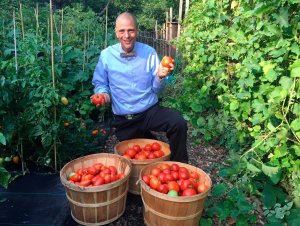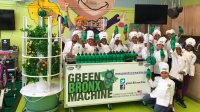5 Lessons for Greening Your Curriculum
Cultivate an indoor farm with inspiration from the Green Bronx Machine.
Your content has been saved!
Go to My Saved Content.On a typical school day in New York City’s South Bronx, students at Community School 55 learn about science, literacy, math, geography, and more by cultivating an indoor farm, turning their harvest into healthy meals and sharing the bounty with others in their community. Remarkably, this state-of-the-art green curriculum has taken root in a hundred-year-old schoolhouse serving the nation’s poorest congressional district.
“If it works in the South Bronx, it can work anywhere,” promises award-winning teacher Stephen Ritz, the high-energy founder of Green Bronx Machine. He built a demonstration classroom—the National Health, Wellness, and Learning Center—on a lean budget and with plenty of sweat equity. It took trial and error to fine-tune his model with the right technologies, cross-curricular learning activities, and professional development to help other teachers get comfortable with a green curriculum. Now, with measurable improvements on everything from attendance to academic performance to graduation rates, Green Bronx Machine offshoots are springing up in schools across the U.S. and around the globe.
Ritz shares insights from his 30-year career as an educational innovator in The Power of a Plant: A Teacher’s Odyssey to Grow Healthy Minds and Schools. (I teamed up with him to write the book, which will be published by Rodale in May.)
In the Classroom
Just in time for Earth Day, Ritz offers five key lessons for teachers, administrators, parents, and community partners interested in greening their schools’ approach to teaching and learning.
1. Put plants at the center. Ritz cultivates learning across subject areas and grade levels by putting plants at the center. In his active classroom, you’re apt to see emerging readers reading aloud to plants. Young scientists design STEAM experiments, make predictions, and gather data about plant growth. Older students develop technical skills that open career pathways. And everyone gets a turn on the spin bikes to power the blenders used to make smoothies.
Although Ritz also gardens with students outdoors, both at school and in community gardens, there’s a big advantage to bringing plants right into the classroom so that hands-on, inquiry-based learning can happen all year round. Ritz uses affordable technology for indoor farming, but teachers can start with milk cartons on a windowsill if that’s all they have available.
2. Find a champion and then recruit allies and partners. Somebody has to love the idea of a green school enough to bring it to life. “Who’s going to be so enthusiastic that others can’t wait to join you?” asks Ritz, whose students once designated him the Dean of Awesomeness. To sustain a green program beyond that initial excitement, it takes a team. Ritz is always on the lookout for potential partners who can help grow a healthy ecosystem for learning. For example, he recruited a former White House chef, Bill Yosses, to teach culinary lessons at C.S. 55 after meeting him at a TEDx event.
Keep your eyes open for allies, but be strategic about forming partnerships. School leaders need to ask questions to clarify partner roles, set expectations, and find out how volunteers are screened or trained to work with your students. Bottom line: Make sure that partnerships will help to achieve your vision for students.

3. Hack the food system. Ritz’s students are growing up in a food desert where junk food is cheap and plentiful but fresh produce is scarce and unaffordable. They’re hacking this unjust food system by taking vegetables home, teaching their families to eat healthier, and sharing the harvest with local food pantries. Inspire your students to analyze food systems through a social justice lens and design projects that put them in the role of local change-makers. As Ritz says, “We grow vegetables and our vegetables grow citizens.”
4. Grow curiosity. Leverage students’ curiosity about the natural world as a springboard for project-based learning. For example, plant-based projects might address these driving questions: How can we reduce food waste on our campus? How can we eat our way to better athletic performance? Does chocolate milk belong on our school lunch menu? How can we reduce hunger in our community? How can we leverage the arts to grow a healthier community?
5. Think globally, grow locally. As his model has spread to new locations, Ritz has connected with educators around the world. His South Bronx students are gaining opportunities to share what they know with classroom farmers in other corners of the globe, from Canada to Dubai. “Everybody eats,” Ritz says simply. Food is an equalizer that can open conversations about culture. Students at C.S. 55, for example, come from around the world. When they grow collards, they connect what they’re learning to home traditions. Immigrant students from Africa and Mexico can compare family collard recipes with African American students. “In the Bronx, my farmer-chefs can go block by block and collect a world of recipes,” Ritz says. Look for similar projects that help your students build global competencies while taking local action.
Check out these curriculum resources and green lesson plan ideas from Green Bronx Machine.
